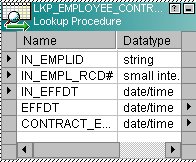| Bookshelf Home | Contents | Index | PDF |   |
|
Oracle® Business Intelligence Applications Installation and Configuration Guide > Configuring Common Components of the Oracle Business Analytics Warehouse > About Resolving Dimension Keys > Resolving the Dimension Key Using LookupIf the dimension key is not provided to the load mapping through database joins, the load mapping performs the lookup in the dimension table. The load mapping does this using prepackaged lookup transformations. The load mapping uses the integration ID, the DATASOURCE_NUM_ID and Lookup date in looking up the dimension key. All these columns are necessary for the load mapping to return the dimension key. The ports are described in Table 45. In Figure 20, the Supplier Products Key Lookup transformation illustrates the three input columns needed for the load mapping lookup—the INTEGRATION ID, DATASOURCE_NUM_ID, and Date (lookup date). The transformation then outputs the Supplier Product key (the dimension key) to the data warehouse table W_SUPPLIER_PRODUCT_D. If Type II slowly changing dimensions are enabled, the load mapping uses the unique effective dates for each update of the dimension records. When a dimension key is looked up, it uses the fact's primary date to resolve the appropriate dimension key. The effective date range gives the effective period for the dimension record. The same entity can have multiple records in the dimension table with different effective periods due to Type II slowly changing dimensions. This effective date range is used to exactly identify a record in its dimension, representing the information in a historically accurate manner. In the lookup for Employee Contract Data shown in Figure 20, you can see the effective dates used to provide the effective period of employee contracts. |
  |
| Oracle® Business Intelligence Applications Installation and Configuration Guide | Copyright © 2007, Oracle. All rights reserved. | |
